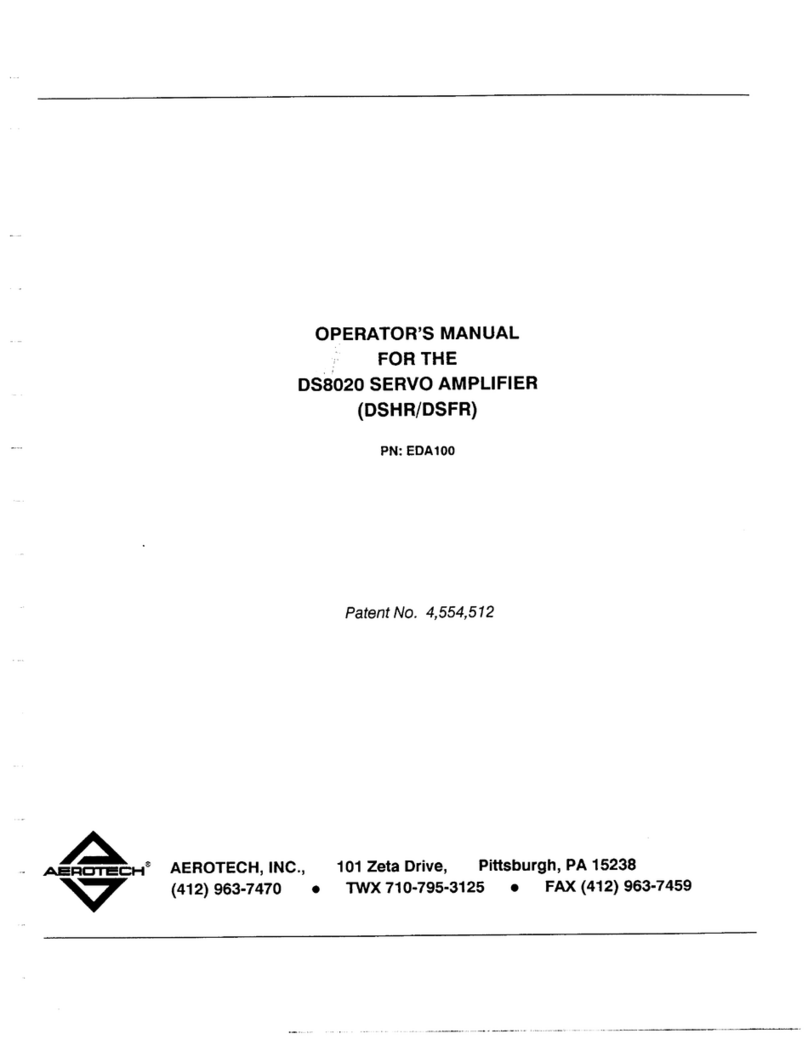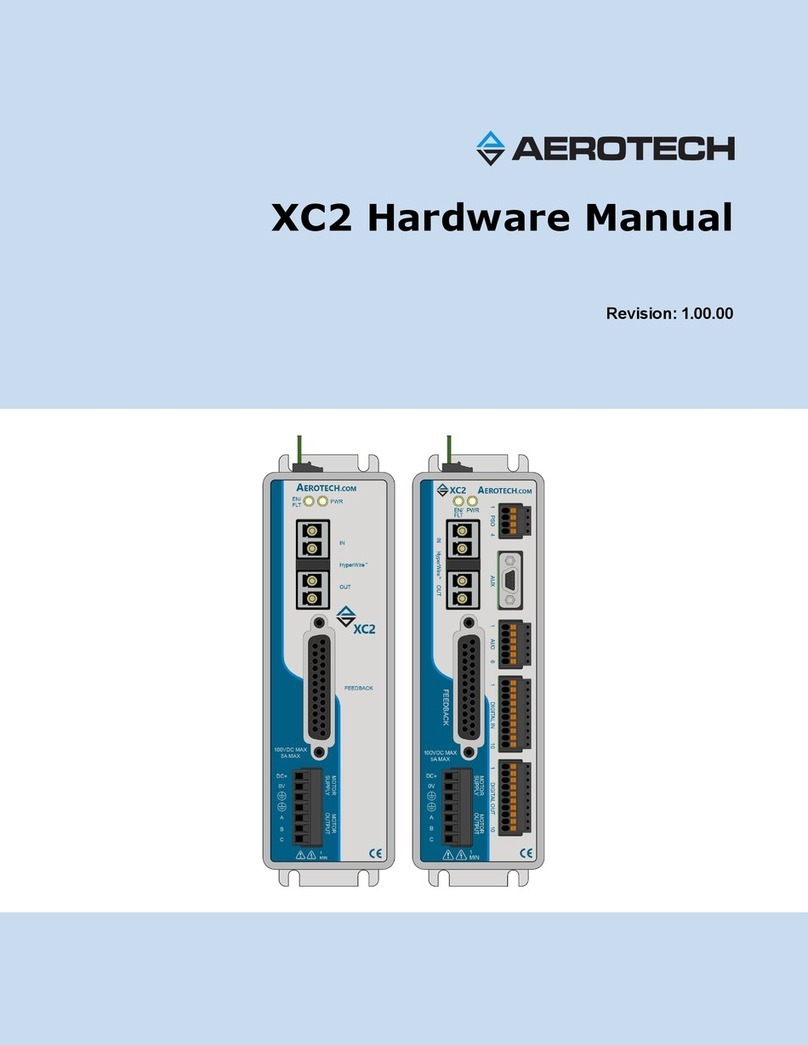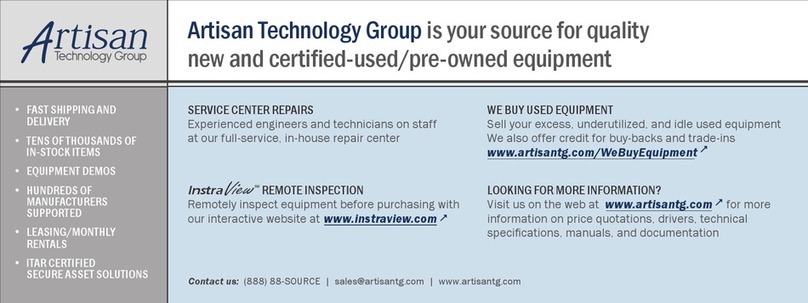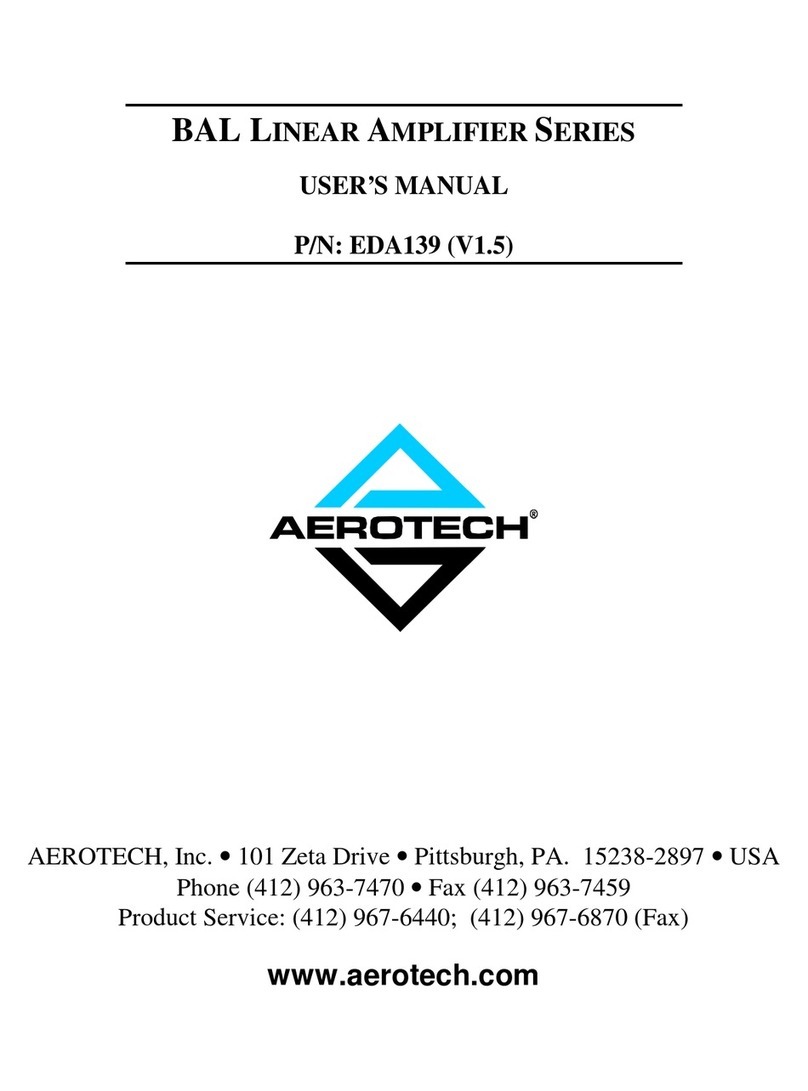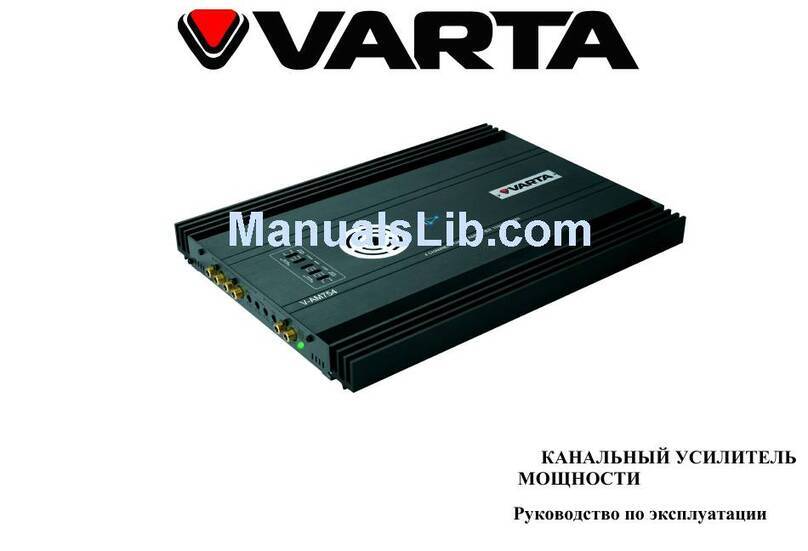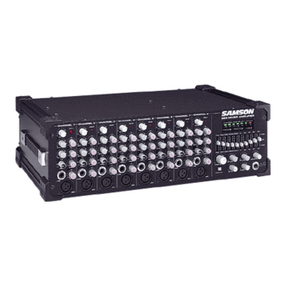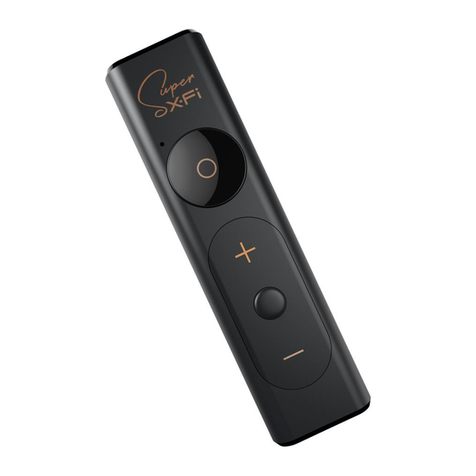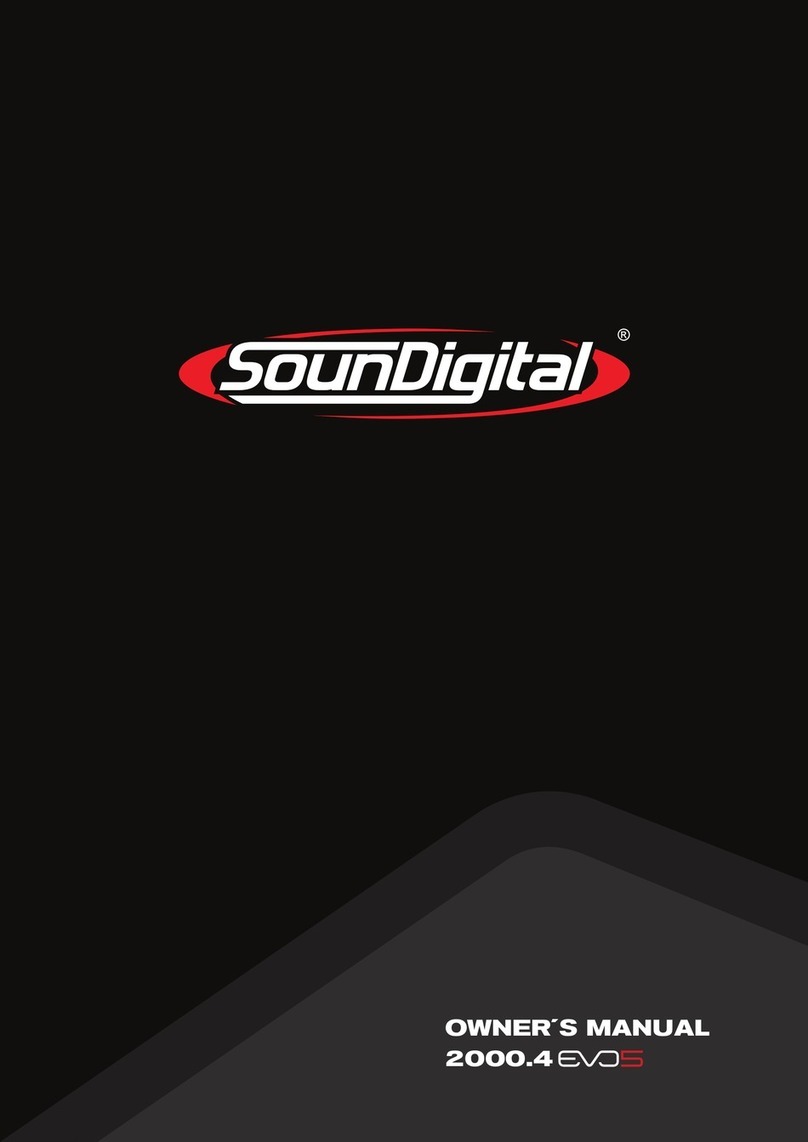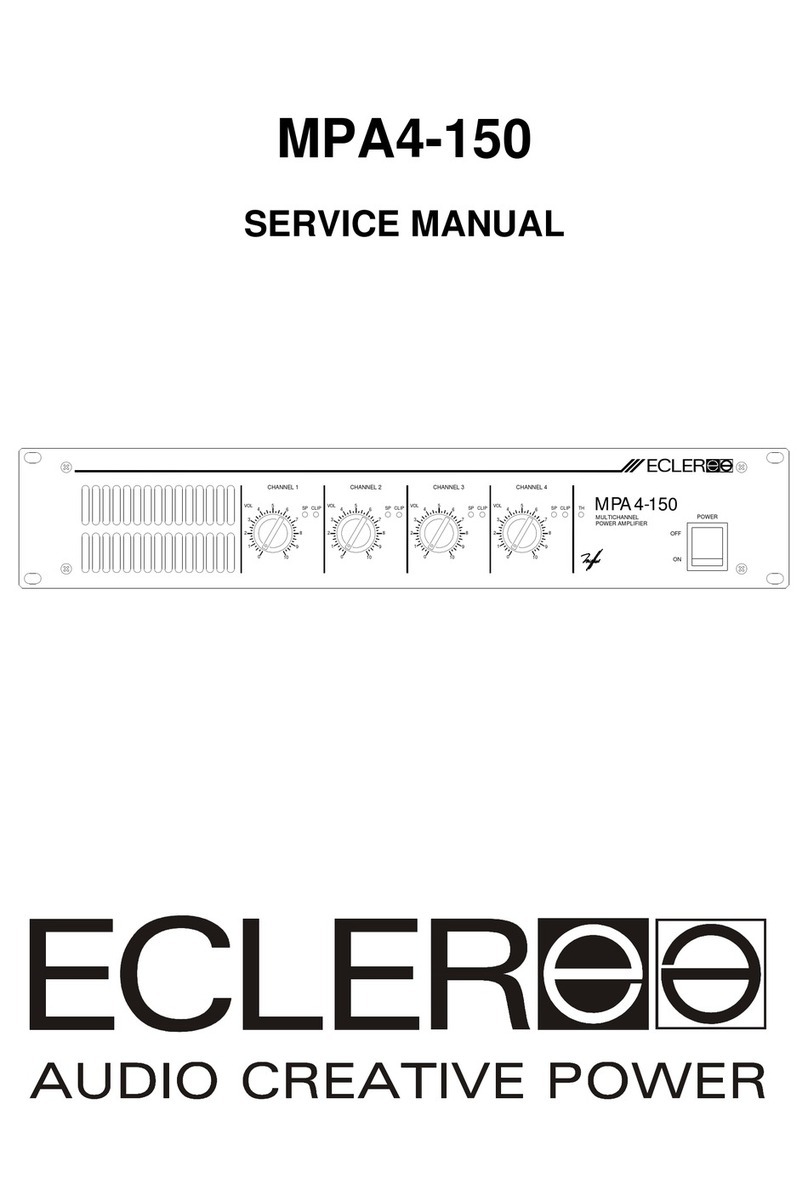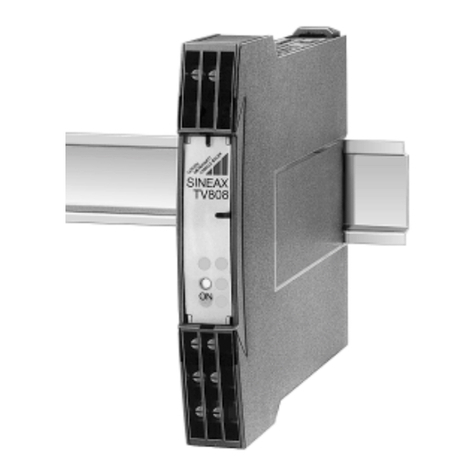Aerotech BL 20-40 User manual

BL
Hardware Manual
(Revision 2.02.00)
Dedicated to the Science of Motion
Aerotech, Inc.
101 Zeta Drive,
Pittsburgh, PA, 15238
Phone: 412-963-7470
Fax: 412-963-7459
www.aerotech.com

Product Registration Register online at www.aerotech.com/prodreg.cfm
Technical Support United States
Phone: (412) 967-6440
Fax: (412) 967-6870
Email: service@aerotech.com
United Kingdom
Phone: +44 118 9409400
Fax: +44 118 9409401
Email: service@aerotech.co.uk
Germany
Phone: +49 911 9679370
Fax: +49 911 96793720
Email: service@aerotechgmbh.de
Japan
Phone: +81(0)47-489-1742
Fax: +81(0)47-489-1743
Email: service@aerotechkk.co.jp
China
Phone: +852 3793 3488
Email: saleschina@aerotech.com
Revision History 2.02.00 11/11/10
2.01.00 6/22/10
2.00.00 3/16/10
1.08 8/11/09
1.07 12/4/06
1.06 2/27/06
1.05 12/12/05
1.04 11/1/04
1.03 8/6/04
1.02 6/7/04
1.01 11/4/03
1.00 1/7/03
This product is intended for light industrial manufacturing or laboratory use.
Product names mentioned herein are used for identification purposes only and may be trademarks of
their respective companies.
Copyright © 2003 - 2010 Aerotech, Inc. All rights reserved.

Table of Contents BL
Table of Contents
List of Figures v
List of Tables vii
EC Declaration of Conformity ix
Chapter 1: Introduction 1
1.1. Electrical Specifications 3
1.2. Mechanical Design 4
1.3. Environmental Specifications 5
Chapter 2: Installation and Configuration 7
2.1. Safety Procedures and Warnings 8
2.2. Power Connections 9
2.2.1. Control Supply Connections 9
2.2.2. Motor Supply Connections 10
2.3. Motor Output Connections (TB101) 11
2.4. DIP Switch 12
2.5. Potentiometers (POTs) 14
2.6. Control Interface Connector (J101) 15
2.6.1. Encoder Inputs (J101) 16
2.6.2. Hall-Effect Inputs (J101) 17
2.6.3. +/- Input 18
2.6.4. Limit Inputs (J101) 19
2.6.5. Current Command Inputs (J101) 20
2.6.6. Tach Input (J101) 21
2.6.7. Shutdown Input (J101) 22
2.6.8. Fault Output (J101) 23
2.7. Motor and Feedback Phasing 24
Chapter 3: Wiring Configurations 29
3.1. Three-Phase Brushless Motors with Unconnected Phases 30
3.2. Velocity Command Configuration 31
3.3. Torque Command Configuration (Current) 33
3.4. Dual-Phase Command Configuration 35
3.5. Differential Dual-Phase Command Configuration 36
3.6. Single Brush Motor 37
3.7. Multiple Brush Motor (requires -TP Option) 38
3.8. Cables 39
Chapter 4: Maintenance 45
4.1. Control Board Assembly 46
4.1.1. Fuse Replacement 49
4.2. Preventative Maintenance 50
Appendix A: Warranty and Field Service 51
Appendix B: Current Changes 53
Index 55
Reader's Comments 57
www.aerotech.com iii

BL Table of Contents
iv www.aerotech.com

List of Figures BL
List of Figures
Figure 1-1: BL Linear Amplifier Connection Overview 1
Figure 1-2: Functional Diagram 2
Figure 1-3: Dimensions 4
Figure 2-1: Control Supply Connections 9
Figure 2-2: Motor Bus Input Connections 10
Figure 2-3: Command Signal Adjustment of the Pre-Amplifier Circuit 14
Figure 2-4: Encoder Inputs 16
Figure 2-5: Hall-Effect Inputs 17
Figure 2-6: ±Input 18
Figure 2-7: Limit Inputs 19
Figure 2-8: Current Command Inputs 20
Figure 2-9: Tach Input 21
Figure 2-10: Shutdown Input 22
Figure 2-11: Fault Output 23
Figure 2-12: Motor Phasing Oscilloscope Example 25
Figure 2-13: Hall Phasing with Oscilloscope 26
Figure 2-14: Brushless Motor Phasing Goal 27
Figure 3-1: Connection of Six Wire Motors to BL Series Amplifiers 30
Figure 3-2: Velocity Command Configuration 31
Figure 3-3: Torque (Current) Command Configuration 33
Figure 3-4: Dual-Phase Command Configuration 35
Figure 3-5: Differential Dual-Phase Command Configuration 36
Figure 3-6: Single Brush Motor Configuration with Tachometer 37
Figure 3-7: Multiple Brush Motor Configuration 38
Figure 4-1: BL Control Board Assembly 46
www.aerotech.com v

BL List Of Figures
vi www.aerotech.com

List of Tables BL
List of Tables
Table 1-1: Amplifier Options 2
Table 1-2: Electrical Specifications 3
Table 1-3: Physical Specifications 4
Table 2-1: Control Supply ACInput Wiring 9
Table 2-2: Control Supply TerminalBlock Mating Connector 9
Table 2-3: Motor Supply Input Wiring 10
Table 2-4: Motor Output Connection 11
Table 2-5: Control Supply TerminalBlock Mating Connector 11
Table 2-6: DIPSwitch Functions 12
Table 2-7: Potentiometer Functions 14
Table 2-8: Connector J101 Pin Assignment 15
Table 3-1: Velocity Command Mode BL Configuration 32
Table 3-2: Torque Command Mode (Current) BL Configuration 34
Table 3-3: Dual-Phase Mode BL Configuration 35
Table 3-4: Differential Dual Phase Mode BL Configuration 36
Table 3-5: Single Brush Motor Mode BL Configuration 37
Table 3-6: Multiple Brush/Torque Command Mode BL Configuration 38
Table 3-7: Motor Cables for Linear Stages 39
Table 3-8: Motor Cables for Combination Stages 41
Table 3-9: Motor Cables for Rotary Stages 42
Table 4-1: Troubleshooting 45
Table 4-2: LEDDescription 45
Table 4-3: Control Board Jumper Selections 47
Table 4-4: Control Board Test Points 48
Table 4-5: BL Fuse Replacement Part Numbers 49
Table 4-6: Line VoltageFuse Information 49
Table 4-7: Preventative Maintenance 50
Table B-1: Revision 2.02.00 Manual Changes 53
Table B-2: Recent Manual Changes 54
www.aerotech.com vii

BL List of Tables
viii www.aerotech.com

Declaration of Conformity BL
EC Declaration of Conformity
Manufacturer Aerotech, Inc.
Address 101 Zeta Drive
Pittsburgh, PA 15238
USA
Product BL
Model/Types All
This is to certify that the aforementioned product is in accordance with the applicable requirements of the fol-
lowing Directive(s):
2006/95/EC Low Voltage Directive
2004/108/EC Electromagnetic Compatibility Directive
and is in conformity with the applicable requirements of the following documents when installed and used in
accordance with the manufacturer’s supplied installation instructions.
EN 61010-1:2001 Safety requirements for electrical equipment
Name / Alex Weibel
Position Engineer Verifying Compliance
Location Pittsburgh, PA
Date September 2010
www.aerotech.com ix
2011/65/EU RoHS 2 Directive

x www.aerotech.com
BL Declaration of Conformity

Introduction BL
Chapter 1: Introduction
The BL Series amplifiers are highly reliable linear brushless servo amplifiers that are easily adaptable to drive
brush or brushless servomotors. The BL amplifier package is a complete modular unit that includes heat
sink, metal cover, control and bus power supplies that operate at ±40 VDC (@ 20 amps peak) or ±80 VDC
(@ 10 amps peak).
The BL drives feature self commutation with analog or digital Hall-effect feedback signals and include a 5
VDC, 250 mA supply to power encoders and Hall-effect devices (HEDs). Each model is jumper selectable,
providing the capability to drive both brush and brushless motors. Complete electrical isolation is provided
between the control stage and the power stage for all models of the BL. This is accomplished with a trans-
former isolated control voltage power supply and opto-isolation of the drive signals, current command signals
and fault signal between the control and power stages.
Operating modes include current command, velocity command or dual-phase command (for brushless
modes of operation only). For brush modes of operation, the available operating modes are current command
and velocity command. Differential inputs are used for better noise immunity. Velocity feedback is from
either an encoder or tachometer and logic inputs include directional current limits and shutdown. Fault, cur-
rent, and velocity outputs simplify monitoring drive status. In addition, there is an option to drive three brush
motors in torque mode.
Figure 1-1: BL Linear Amplifier Connection Overview
www.aerotech.com Chapter 1 1

BL Introduction
Table 1-1: Amplifier Options
BL Series Linear Amplifiers
BL10-40-x ±40 V output (80 V bus) and 10 A peak current, with cooling fan and isolation transformer.
BL10-80-x ±80 V output (160 V bus) and 10 A peak current, with cooling fan and autotransformer.
BL20-40-x ±40 V output (80 V bus) and 20 A peak current, with cooling fan and isolation transformer.
x = A for 115 VAC single phase input power (standard)
x = B for 230 VAC single phase input power
x = C for 100 VAC single phase input power
x = D for 200 VAC single phase input power
Options
-VM1 Brushless motor, electronic Tachometer, 0° commutation offset (Aerotech standard )
-VM2 Brushless motor, electronic Tachometer, 30° commutation offset
-VM3 Brush motor, analog Tachometer
-VM4 Brush motor, electronic Tachometer
-CM1 Brushless motor, 0° commutation offset (Aerotech Standard)
-CM2 Brushless motor, 30° commutation offset
-CM3 Brush motor
-AH Analog Hall
-TP Three independent current regulators (one enable/fault )
-DDP Brushless motor, differential dual phase current commands
-PKnPeak current output n% of max
(where ncan equal 6, 13, 19, 27, 33, 40, 46, 54, 60, 67, 73, 81, 87, 94, 100)
-CCnContinuous current output before automatic shutdown n% of max
(where ncan equal 3, 7, 10, 14, 17, 21, 24, 27, 30, 34, 37, 41, 44, 47, 50)
Figure 1-2: Functional Diagram
2 Chapter 1 www.aerotech.com

Introduction BL
1.1. Electrical Specifications
The electrical specifications for the BL are listed below.
Table 1-2: Electrical Specifications
Description BL 20-40 BL 10-40 BL 10-80
Motor Supply Input Voltage 100, 115, 200, 230 VAC (model dependent)
Input Frequency 50-60 Hz
Inrush Current 10, 11.5, 20, 23 A (model dependent)
Maximum Con-
tinuous Input Cur-
rent
5.66 Arms 2.83 Arms 5.66 Arms
Control Supply Input Voltage 85-240 VAC
Input Frequency 50-60 Hz
Inrush Current 16 A
Input Current .25 A max
Output Voltage (1) ±36V @ 20A ±38V @ 20A ±78V @ 10A
Peak Output Current 20 10 10
Continuous Output Current 10 5 5
Power Amplifier Bandwidth 2 kHz
Minimum Load Resistance 0.5 Ω
Output Impedance 0.2 Ω (each phase)
User Power Supply Output 5 VDC (@ 500 mA)
Modes of Operation Brushless; Brush; Stepper
Protective Features Peak current limit; Over temperature; RMS current limit;
Dynamic power dissipation limit; Designed to EN61010/UL3101
Isolation Optical and transformer isolation between control and power
stages.
(1) Load Dependent
www.aerotech.com Chapter 1 3

BL Introduction
1.2. Mechanical Design
Each unit should be separated from other drives and surrounded by 50 mm (2") of free air space. A space of
100 mm (4") should be allowed along the front of the unit for cable connections.
Figure 1-3: Dimensions
Table 1-3: Physical Specifications
Model Weight
BL 8.5 kg [18.8 lb]
4 Chapter 1 www.aerotech.com

Introduction BL
1.3. Environmental Specifications
The environmental specifications for the BL are listed below.
Ambient Temperature Operating: 5° to 40°C (41° to 104° F)
Storage: -20° to 70°C (-4° to 158° F)
Humidity Maximum relative humidity is 80% for temperatures up to 31°C. Decreas-
ing linearly to 50% relative humidity at 40°C. Non condensing.
Altitude Up to 2000 meters.
Pollution Pollution degree 2 (normally only non-conductive pollution).
Use Indoor use only.
www.aerotech.com Chapter 1 5

BL Introduction
6 Chapter 1 www.aerotech.com

Installation and Configuration BL
Chapter 2: Installation and Configuration
This section covers the hardware configurations using the switches, jumpers, connectors, and power hook-
ups when used with a brush or brushless DC motor. Wiring, grounding, and shielding techniques, an expla-
nation of the current regulator adjustment and the motor phasing process are also covered in this section.
N O T E : Aerotech brushless motors should be configured for 0° Hall commutation shift. Motors from other
manufacturers may require a 30° Hall commutation offset. Consult the motor manufacturer for details.
The BL amplifier must be installed inside an enclosure with construction compliant for use with unlimited cir-
cuits. The BL amplifier can be lifted and transported using both hands to hold and support the case of the
amplifier. The BL amplifier must be mounted with at least 2 inches of ventilation space around all sides the
amplifier. Additional ventilation and cooling requirements are determined by the application. See Section 1.2.
Mechanical Design for the BL amplifier and mounting dimensions.
Do not hold the BL amplifier by the connectors, and be careful of all sharp edges and hardware to
prevent bodily injury and damage to amplifier.
www.aerotech.com Chapter 2 7

BL Installation and Configuration
2.1. Safety Procedures and Warnings
The following statements apply wherever the Warning or Danger symbol appears within this manual. Failure
to observe these precautions could result in serious injury to those individuals performing the procedures
and/or damage to the equipment. Operators should be trained before operating this equipment.
N O T E : The BL (all Aerotech equipment) is not to be used in a manner not specified by Aerotech, Inc.
To minimize the possibility of bodily injury and electrical shock, make certain that electrical
power is disconnected (Mains disconnect) from amplifier before performing system maintenance
or wiring.
Risk of injury during operation due to moving parts connected to the BL.
Residual voltages greater than 60V can be present inside and at the terminals of the BL amplifier
for longer than 5 seconds after power has been disconnected.
All service and maintenance must be performed by qualified personnel.
Improper operation of this equipment may result in personal injury. The user must read this man-
ual and related documentation thoroughly before operating the equipment.
Use of this product in a manner other than its intended use may result in bodily injury and/or dam-
age to the equipment.
The BL case temperature may exceed 75°C in some applications.
N O T E : All drawings and illustrations are for reference only and were complete and accurate as of this
manual’s release. The most recent system drawings and schematics can be found on your software CD
ROM.
8 Chapter 2 www.aerotech.com

Installation and Configuration BL
2.2. Power Connections
The BL has two AC input connectors; one for control power, and a second for motor power. For a complete
list of electrical specifications, refer to Section 1.1.
2.2.1. Control Supply Connections
The control power supply input allows the BL to maintain communications if the motor power is removed,
such as in an Emergency Stop condition. The control power supply requires a minimum of 85 VAC input to
operate properly. The AC1 input is internally fused (at 3 A). AC2 may require an external fuse or circuit
breaker (3 A, time delay).The figure below shows the required connections to the control power input.
N O T E : This product requires two power supply connections. The Motor Supply and Control Supply must
both be connected for proper operation.
Figure 2-1: Control Supply Connections
Table 2-1: Control Supply ACInput Wiring
Pin Description Recommended Wire Size
AC1 85-240 VAC Control Power Input 2.00 mm2(#14 AWG)
AC2 85-240 VAC Control Power Input 2.00 mm2(#14 AWG)
Protective Ground (Required for Safety) 2.00 mm2(#14 AWG)
Table 2-2: Control Supply TerminalBlock Mating Connector
Type Aerotech P/N Phoenix P/N Wire Size: AWG [mm2]
3-Pin Terminal Block ECK00213 1754465 12-30 [3.3 - 0.0516]
www.aerotech.com Chapter 2 9

BL Installation and Configuration
2.2.2. Motor Supply Connections
Motor power is applied at the three terminals of the MAIN SUPPLY connector.
N O T E : This product requires two power supply connections. The Motor Supply and Control Supply must
both be connected for proper operation.
External fuses or a circuit breaker (10 A maximum, time delay type) are required for the AC1 and
AC2 inputs for branch protection. The protective device should be located near the drive.
Figure 2-2: Motor Bus Input Connections
Table 2-3: Motor Supply Input Wiring
Pin Description Wire Size
AC1 115/100/208/230 Volt ACInput 2.0 mm2(#14 AWG)
AC2 115/100/208/230 Volt ACInput 2.0 mm2(#14 AWG)
Protective Ground (Required for Safety) 2.0 mm2(#14 AWG)
10 Chapter 2 www.aerotech.com
This manual suits for next models
2
Table of contents
Other Aerotech Amplifier manuals
Popular Amplifier manuals by other brands
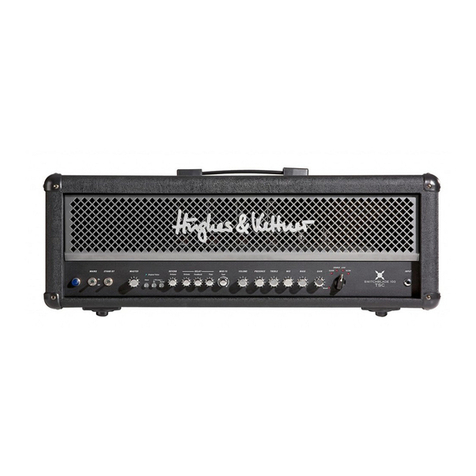
Hughes & Kettner
Hughes & Kettner SWITCHBLADE TSC Head 100 manual
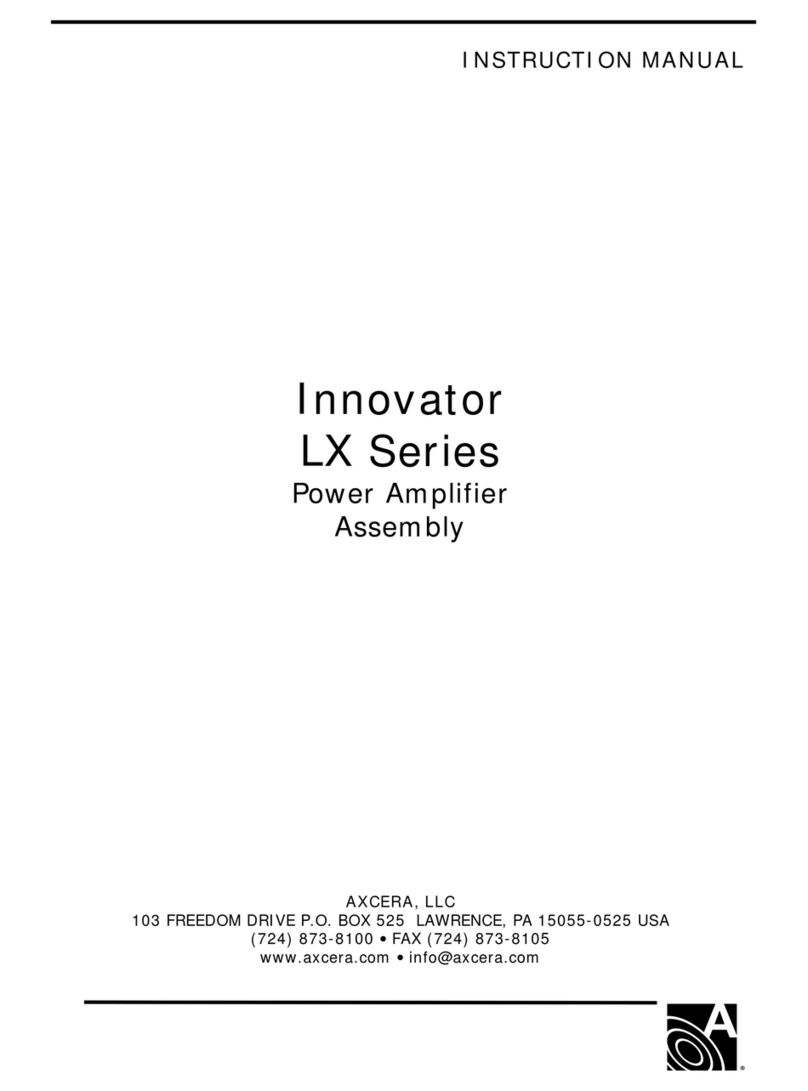
Axcera
Axcera Innovator LX Series instruction manual

Marshall Amplification
Marshall Amplification MEGASTACK MG15FXMSDM manual
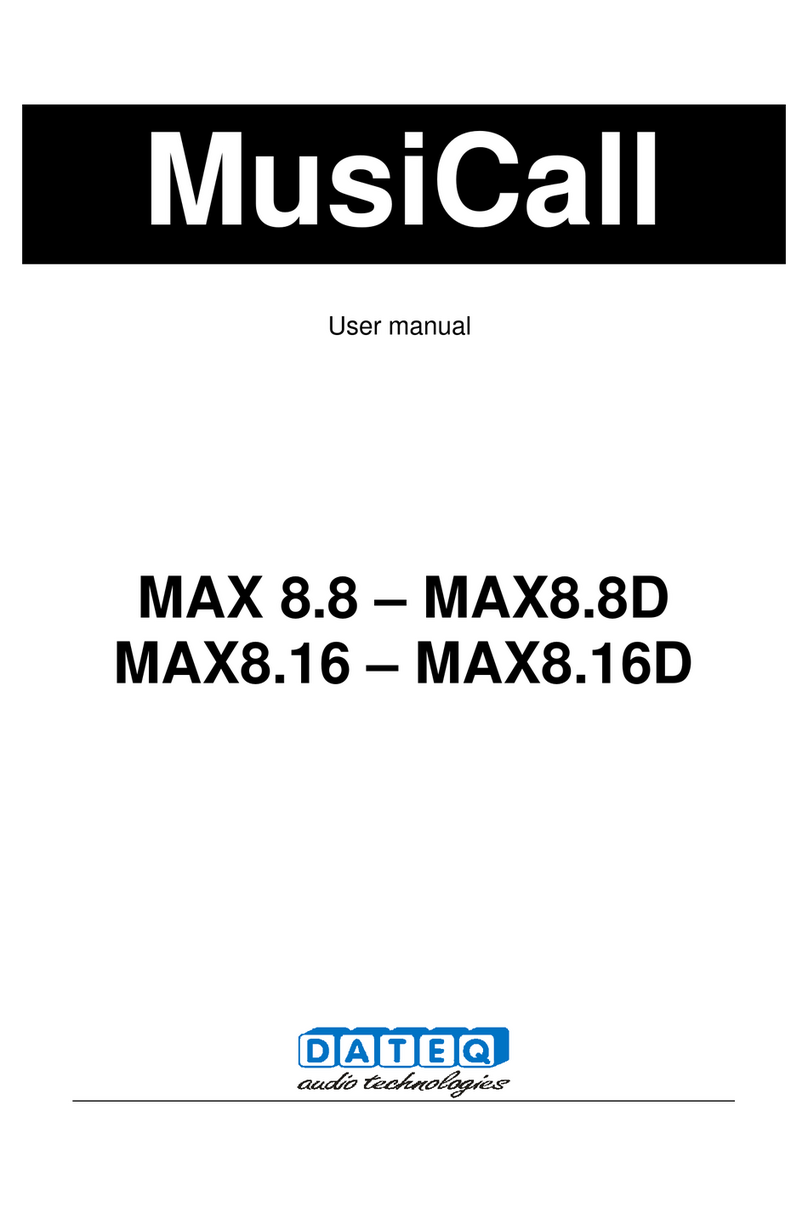
Dateq
Dateq Musicall MAX8.8 user manual

Niles
Niles FG01703 installation guide
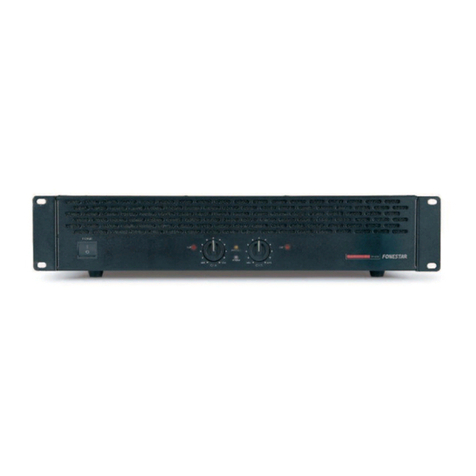
FONESTAR
FONESTAR SA-204 instruction manual
